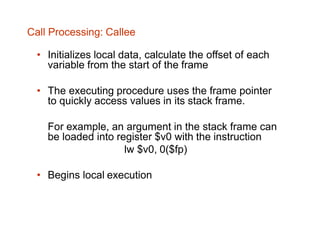Lecture 14 run time environment
- 2. Run-time Environment • Compiler must cooperate with OS and other system software to support implementation of different abstractions (names, scopes, bindings, data types, operators, procedures, parameters, flow-of-control) on the target machine • Compiler does this by Run-Time Environment in which it assumes its target programs are being executed • Run-Time Environment deals with – Layout and allocation of storage – Access to variable and data – Linkage between procedures – Parameter passing – Interface to OS, I/O devices etc
- 3. Storage Organization Code Static Heap Free Memory Stack • Compiler deals with logical address space • OS maps the logical addresses to physical addresses Memory locations for code are determined at compile time. Usually placed in the low end of memory Size of some program data are known at compile time – can be placed another statically determined area Dynamic space areas – size changes during program execution. • Heap • Grows towards higher address • Stores data allocated under program control • Stack • Grows towards lower address • Stores activation records Typical subdivision of run-time memory
- 4. Run-Time Environments • How do we allocate the space for the generated target code and the data object of our source programs? • The places of the data objects that can be determined at compile time will be allocated statically. • But the places for the some of data objects will be allocated at run-time. • The allocation and de-allocation of the data objects is managed by the run-time support package. – run-time support package is loaded together with the generated target code. – the structure of the run-time support package depends on the semantics of the programming language (especially the semantics of procedures in that language).
- 5. Procedure Activations • Each execution of a procedure is called as activation of that procedure. • An execution of a procedure P starts at the beginning of the procedure body; • When a procedure P is completed, it returns control to the point immediately after the place where P was called. • Lifetime of an activation of a procedure P is the sequence of steps between the first and the last steps in execution of P (including the other procedures called by P). • If A and B are procedure activations, then their lifetimes are either non-overlapping or are nested. • If a procedure is recursive, a new activation can begin before an earlier activation of the same procedure has ended.
- 6. A call graph is a directed multi-graph where: • the nodes are the procedures of the program and • the edges represent calls between these procedures. Used in optimization phase. Acyclic € no recursion in the program Can be computed statically. Call Graph
- 7. var a: array [0 .. 10] of integer; procedure main begin readarray(); quicksort(1,9); end procedure readarray var i: integer begin … a[i] … end function partition(y,z: integer): integer var i,j,x,v: integer begin … end procedure quicksort(m,n: integer) var i: integer begin i := partition(m,n); quicksort(m,i-1); quicksort(i+1,n) end Main quicksort readarray partition Example: Call Graph
- 8. Activation Tree/ Call Tree • We can use a tree (called activation tree) to show the way control enters and leaves activations. • In an activation tree: – Each node represents an activation of a procedure. – The root represents the activation of the main program. – The node A is a parent of the node B iff the control flows from A to B. – The node A is left to to the node B iff the lifetime of A occurs before the lifetime of B.
- 9. Activation Tree (cont.) program main; procedure s; begin ... end; procedure p; procedure q; begin ... end; begin q; s; end; begin p; s; end; enter main enter p enter q exit q enter s exit s exit p enter s exit s exit main A Nested Structure
- 10. Activation Tree (cont.) main p s q s
- 11. • Activation Tree - cannot be computed statically • Dynamic – may be different every time the program is run main r() q (1,9) p (1,9) q(1,3) q (5,9) p (1,3) q(1,0) q (2,3) p (5,9) q(5,5) q (7,9) p (2,3) q(2,1) q (3,3) p (7,9) q(7,7) q (9,9) Activation Tree
- 12. Paths in the activation tree from root to some node represent a sequence of active calls at runtime main r() q (1,9) p (1,9) q(1,3) q (5,9) p (1,3) q(1,0) q (2,3) p (5,9) q(5,5) q (7,9) p (2,3) q(2,1) q (3,3) p (7,9) q(7,7) q (9,9) Run-time Control Flow
- 13. • Procedure call/return – when a procedure activation terminates, control returns to the caller of this procedure. • Parameter/return value – values are passed into a procedure activation upon call. For a function, a value may be returned to the caller. • Variable addressing – when using an identifier, language scope rules dictate the binding. Implementing Run-time control flow
- 14. • Historically, the first approach to solve the run- time control flow problem (Fortran) • All space allocated at compile time – Code area – machine instructions for each procedure – Static area / procedure call frame/ activation record • single data area allocated for each procedure. – local vars, parameters, return value, saved registers • return address for each procedure. Static Allocation
- 15. Code area Data area for procedure A Data area for procedure BCode generated for A Code generated for B return addr return addr Local data, parameters, return value, registers for A Local data, parameters, return value, registers for B Static Allocation
- 16. • When A calls B: – in A: evaluate actual parameters and place into B’s data area, place RA in B’s data area, save any registers or status data needed, update the program counter (PC) to B’s code • When the call returns – in B: move return value to known place in data area, update PC to value in RA – in A: get return value, restore any saved registers or status data Call/Return processing in Static Allocation
- 17. Code area Activation for procedure A Activation for procedure B A: call B L1: B: … return PC Call tree: A Local data, parameters, return value, registers for A Local data, parameters, return value, registers for B Static Allocation
- 18. Static Allocation Code area Activation for procedure A Activation for procedure B A: call B L1: B: … return L1 dataLocal for A Local data for B PC Call tree: A B
- 19. Static Allocation Code area Activation Activation A: call B L1: B: … return for pro A cedure for procedure B L1 Local for A data Local data for B PC Call tree: A
- 20. Activation for procedure A Code area A: call B return addr dataLocal for A Activation for procedure B return addr Local data for B B: call B L2: What happens??? Static Allocation: Recursion?
- 21. Code area Activation for procedure A Activation for procedure B A: call B L1: B: call B L2: return dataLocal for A Local data for B PC Call tree: A Static Allocation: Recursion
- 22. Code area Activation for procedure A Activation for procedure B A: call B L1: B: call B L2: return dataLocal for A Local data for B PC L1 Call tree: A B Static Allocation: Recursion
- 23. Code area Activation for procedure A Activation for procedure B A: call B L1: B: call B L2: return dataLocal for A Local data for B PC L2 Call tree: A B B Static Allocation: Recursion
- 24. Code area Activation for procedure A Activation for procedure B A: call B L1: B: call B L2: return dataLocal for A Local data for B PC L2 Call tree: A B Static Allocation: Recursion
- 25. Code area Activation for procedure A Activation for procedure B A: call B L1: B: call B L2: return dataLocal for A dataLocal for B PC L2 Call tree: A B We’ve lost the L1 label so we can’t get back to A Static Allocation: Recursion
- 26. • Variable addresses hard-coded, usually as offset from data area where variable is declared. addr(x) = start of x's local scope + x's offset Runtime Addressing in Static Allocation
- 27. Need a different approach to handle recursion. • Code area – machine code for procedures • Static data – often not associated with procedures • Stack (Control Stack) – runtime information Stack Allocation
- 28. Control Stack • The flow of the control in a program corresponds to a depth-first traversal of the activation tree that: – starts at the root, – visits a node before its children, and – recursively visits children at each node an a left-to-right order. • A stack (called control stack) can be used to keep track of live procedure activations. – An activation record is pushed onto the control stack as the activation starts. – That activation record is popped when that activation ends. – Dynamic – grows and shrinks • When node n is at the top of the control stack, the stack contains the nodes along the path from n to the root.
- 29. Variable Scopes • The same variable name can be used in the different parts of the program. • The scope rules of the language determine which declaration of a name applies when the name appears in the program. • An occurrence of a variable (a name) is: – local: If that occurrence is in the same procedure in which that name is declared. – non-local: Otherwise (ie. it is declared outside of that procedure) a is local b is non-local procedure p; var b:real; procedure q; var a: integer; begin a := 1; b := 2; end; begin ... end;
- 30. Activation Records • Information needed by a single execution of a procedure is managed using a contiguous block of storage called activation record. • An activation record is allocated when a procedure is entered, and it is de-allocated when that procedure exited. • Size of each field can be determined at compile time (Although actual location of the activation record is determined at run-time). – Except that if the procedure has a local variable and its size depends on a parameter, its size is determined at the run time.
- 31. Activation Records (cont.) return value actual parameters optional control link optional access link saved machine status local data temporaries The returned value of the called procedure is returned in this field to the calling procedure. In practice, we may use a machine register for the return value. The field for actual parameters is used by the calling procedure to supply parameters to the called procedure. The optional control link points to the activation record of the caller. The optional access link is used to refer to nonlocal data held in other activation records. The field for saved machine status holds information about the state of the machine before the procedure is called. The field of local data holds data that local to an execution of a procedure.. Temporary variables is stored in the field of temporaries.
- 32. Activation Records (Ex1) program main; procedure p; var a:real; procedure q; var b:integer; begin ... end; begin q; end; procedure s; var c:integer; begin ... end; begin p; s; end; main p a: q b: stack main p q s
- 33. Activation Records for Recursive Procedures program main; procedure p; function q(a:integer):integer; begin if (a=1) then q:=1; else q:=a+q(a-1); end; begin q(3); end; begin p; end; main p a: 3 q(3) a:2 q(2) a:1 q(1)
- 34. Stack (growing downward)Call Tree Main readarray Main a: array readarray i: integer Stack Allocation for quicksort 1
- 35. Stack (growing downward) Main a: array quick(1,9) i: integer Call Tree Main readarray quick(1,9) Stack Allocation for quicksort 2
- 36. Stack (growing downward)Call Tree Main readarray quick(1,9) quick(1,3) quick(1,0) p(1,9) p(1,9) Main a: array quick(1,9) i: integer quick(1,3) i: integer quick(1,0) i: integer Stack Allocation for quicksort 3
- 37. Frame pointer $fp: points to the first word of the frame, Stack pointer ($sp): points to the last word of the frame. The frame consists of the memory between locations pointed by $fp and $sp Layout of the stack frame
- 38. Creation of An Activation Record • Who allocates an activation record of a procedure? – Some part of the activation record of a procedure is created by that procedure immediately after that procedure is entered. – Some part is created by the caller of that procedure before that procedure is entered. • Who deallocates? – Callee de-allocates the part allocated by Callee. – Caller de-allocates the part allocated by Caller.
- 39. Creation of An Activation Record (cont.) return value actual parameters optional control link optional access link saved machine status local data temporaries return value actual parameters optional control link optional access link saved machine status local data temporaries Callee’s Responsibility Caller’s Activation Record Caller’s Responsibility Callee’s Activation Record
- 40. Callee’s responsibilities before running • Allocate memory for the activation record/frame by subtracting the frame’s size from $sp • Save callee-saved registers in the frame. A callee must save the values in these registers ($s0–$s7, $fp, and $ra) before altering them [since the caller expects to find these registers unchanged after the call.] – Register $fp is saved by every procedure that allocates a new stack frame. – $ra only needs to be saved if the callee itself makes a call. – The other callee-saved registers that are used also must be saved. • Establish the frame pointer by adding the stack frame’s size minus four to $sp and storing the sum in $fp.
- 41. • Pass arguments: By convention, the first four arguments are passed in registers $a0–$a3. Any remaining arguments are pushed on the stack and appear at the beginning of the called procedure’s stack frame. • Save caller-saved registers: The called procedure can use these registers ($a0–$a3 and $t0–$t9) without first saving their value. If the caller expects to use one of these registers after a call, it must save its value before the call. • Execute a jal instructionwhich jumps to the callee’s first instruction and saves the return address in register $ra. Caller’s Responsibility
- 42. Call Processing: Callee • Initializes local data, calculate the offset of each variable from the start of the frame • The executing procedure uses the frame pointer to quickly access values in its stack frame. For example, an argument in the stack frame can be loaded into register $v0 with the instruction lw $v0, 0($fp) • Begins local execution
- 43. • If the callee is a function that returns a value, place the returned value in a special register e.g. $v0. • Restore all callee-saved registers that were saved upon procedure entry. • Pop the stack frame by adding the frame size to $sp. • Return by jumping to the address in register $ra. Added at the ‘return’ point(s) of the function Callee’s responsibilities on returning
- 44. • Restore registers and status • Copy the return value (if any) from activation • Continue local execution Added after the point of the call Return Processing: Caller
- 45. Any Question ?






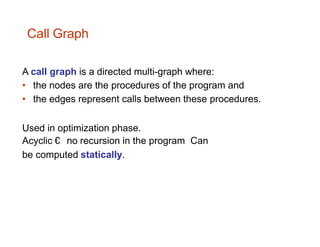
![var a: array [0 .. 10] of integer;
procedure main
begin readarray(); quicksort(1,9); end
procedure readarray
var i: integer
begin … a[i] … end
function partition(y,z: integer): integer
var i,j,x,v: integer
begin … end
procedure quicksort(m,n: integer)
var i: integer
begin i := partition(m,n); quicksort(m,i-1); quicksort(i+1,n) end
Main
quicksort
readarray
partition
Example: Call Graph](https://image.slidesharecdn.com/lecture14runtimeenvironment-151115034357-lva1-app6892/85/Lecture-14-run-time-environment-7-320.jpg)





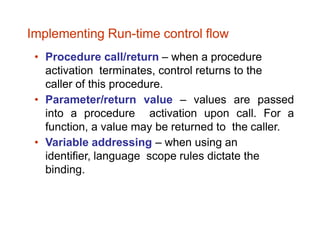

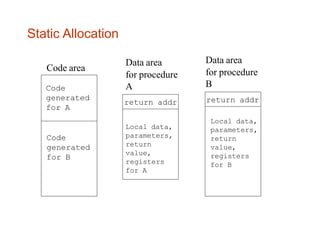
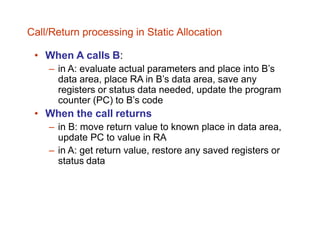

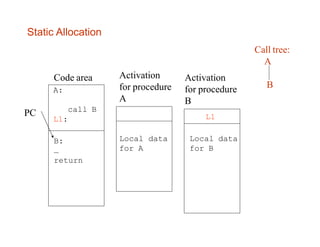
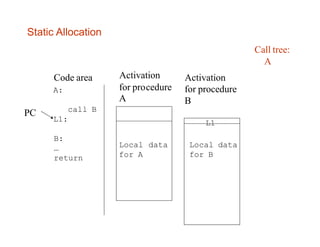
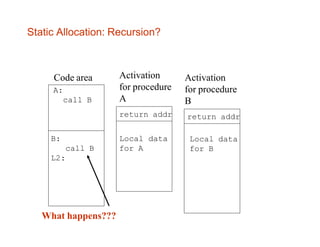

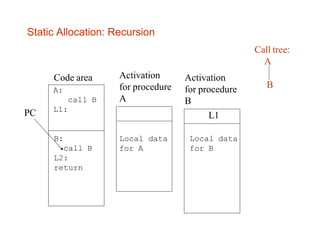

















![Callee’s responsibilities before running
• Allocate memory for the activation record/frame by
subtracting the frame’s size from $sp
• Save callee-saved registers in the frame. A callee must save
the values in these registers ($s0–$s7, $fp, and $ra) before
altering them
[since the caller expects to find these registers unchanged after
the call.]
– Register $fp is saved by every procedure that allocates a new
stack frame.
– $ra only needs to be saved if the callee itself makes a call.
– The other callee-saved registers that are used also must be saved.
• Establish the frame pointer by adding the stack frame’s size
minus four to $sp and storing the sum in $fp.](https://image.slidesharecdn.com/lecture14runtimeenvironment-151115034357-lva1-app6892/85/Lecture-14-run-time-environment-40-320.jpg)

